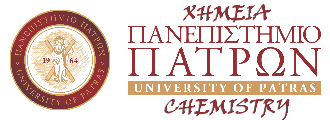
Assistant Professor
Tel: (+302610) 997702
Web Page: http://www.chem.upatras.gr/faculty/andreopoulou
List of Publications:
Curriculum Vitae
EDUCATION
11.2004 : PhD Interdepartmental Postgraduate Program on Polymer Science and Technology, Departments of Chemical Engineering, Chemistry and Physics, University of Patras, Greece
09.2001: MSc Interdepartmental Postgraduate Program on Polymer Science and Technology, Departments of Chemical Engineering, Chemistry and Physics, University of Patras, Greece
1999 : BSc in Chemistry, Department of Chemistry, University of Patras, Greece
PREVIOUS POSITIONS
11/2004-2022 Contracted & Post Doctoral Researcher at the Departments of Chemistry, of Chemical Engineering and of Mechanical Engineering and Aeronautics, University of Patras, Greece; Institute of Chemical Engineering Science, ICEHT/FORTH, Greece; ADVENT TECHNOLOGIES S.A., Greece; Department of Chemistry, Roy & Diana Vagelos Laboratories, University of Pennsylvania, Philadelphia PA, USA.
RESEARCH ACTIVITIES: •Development of functional polymeric materials for energy related applications such as for polymer electrolyte membrane fuel cells, polymer bulk heterojunction solar cells, dye sensitized solar cells, polymer/organic light emitting diodes. •Development of hybrid polymeric materials with carbon nanostructures (e.g. carbon nanotubes, fullerenes) with inorganic nanoparticles (e.g. Ag NPs, TiO2 NPs) with metal ions forming metallocomplexes (e.g. Ruthenium, Iridium) •Synthesis of Polymeric and Copolymeric Ionic Liquids •Polymer and Polymer nanoparticles (polymer beads) with antimicrobial and antifouling properties. •Synthesis and characterization of dendrons, dendrimers and dendronized polymers
MOBILITY: 11/2005- 11/2006: Post Doctoral Fellow, Department of Chemistry, Roy & Diana Vagelos Laboratories, University of Pennsylvania, Philadelphia PA, USA
2/2003 – 5/2003: Marie-Curie-Training Site “Methods of Polymer Characterization” HPMT-CT-2000-00015, Max-Planck Institute for Polymer Research, Mainz Germany.
PARTICIPATION IN RESEARCH PROJECTS: 2001-2022: 23 EU and national research projects
COMMISSIONS OF TRUST
- L'ORÉAL-UNESCO 2008 Greek Award for Women in Science, in the Material Science Area.
- Reviewer of: Angewandte. Chem., Macromolecules, Journal of Molecular Structure, ChemPhysChem, Materials Today Proceedings, PLoS ONE, Nanoscience and Nanotechnology Letters, Polymers, MRS Communications, Nanomaterials, Materials al.
- Scholarship Marie-Curie-Training Site “Methods of Polymer Characterization” HPMT-CT-2000-00015, Max-Planck Institute for Polymer Research, Mainz Germany.
- Independent Remote Expert, Evaluator-Rapporteur, in Stage 1 FP7-NMP-2013-Small-7, NMP-2013-4.0-2 "Innovative materials for efficient, stable and cheap organic photovoltaic cells" November 2012; and in H2020 FET OPEN RIA Call 2015/2, cut-off date 29/9/2015: FET-OPEN - Novel Ideas For Radically New Technologies –Research and Innovation Actions (RIA)
- Vice Chair-Cross-reader in H2020-FETOPEN-1-2016-2017-RIA and H2020-FETOPEN-01-2018-2019-2020 cut-off dates 27-9-2017, 16-5-2018, 24-1-2019, 18-9-2019, 3-6-2020 and HORIZON-EIC-2022-PATHFINDEROPEN-01 cut-off date 4.05.2022.
- Monitoring of Funded Research Projects: Fuel Cells and Hydrogen 2 Joint Undertaking (FCH2)-RIA. 2019; H2020-FETOPEN-01-2018-2019-2020-FETOPEN-RIA-2020.01, in review meetings at 2020, 2021, 2022
OVERVIEW OF PUBLICATIONS: 59 refereed journal publications with total citations >900; h-index = 18,
9 patent applications/4 granted patents; 5 chapters in books.
Guest Editor: Special Issue “Hybrid Polymeric Materials II”, Co-Editor with J.K. Kallitsis, Polymers 2020
CONFERENCE PARTICIPATION/ATTENDANCE: Attendance of >60 international and national conferences with oral and poster presentations and 5 Invited Oral Presentations.
Courses
Undergraduate courses
Chemistry and Technology of Materials (polymers, nanomaterials colloids, catalysts) (6th semester)
Physical Processes of Chemical Technology (7th semester)
Undergraduate laboratory courses
Chemistry and Technology of Materials (polymers, nanomaterials colloids, catalysts) (6th semester)
Laboratory courses in Physical Processes of Chemical Technology (6th semester)
Physical Processes of Chemical Technology (7th semester)
Postgraduate courses
(Department of Chemistry, Specialization “Chemistry and Technology of Materials with Applications to Industry, Energy and Environment")
Chemistry of Polymeric Materials
Technological Applications of Polymeric Materials to Industry, Energy and Environment
Research Activities
1. Organic and Polymeric Hybrid Materials
The combination of organic and polymeric segments with metallocomplexes, carbon nanostructures or inorganic nanoparticles creating hybrid materials. The final materials’ properties can be thus manipulated in terms of solubility, processability as well as electrooptical and physicochemical properties modulation. Thus, are created:
metallopolymers comprising terpyridine-Ru(II)-terpyridine complexes and bis-cyclometalated Iridium(III) complexes or bis-tridendate Iridium(III) metallocomplexes
modified carbon nanotubes or fullerenes with semiconducting molecules, polymers or metallocomplexes
functionalized inorganic NPs bearing semiconducting organic moieties or polymers
Co-polymeric ionic liquids (PILs)
The hybrid materials are applied in organic electronics, such as organic light emitting diodes, organic photovoltaics, and dye sensitized solar cells (DSSCs). The PILs are also employed as quasi solid electrolytes
2. Semiconducting Organic, Polymeric and Hybrid Materials for Organic Electronics
Conjugated semiconducting organic molecules and polymers are developed for applications in the fields of organic electronics like organic photovoltaics (OPVs), dye sensitized solar cells (DSSCs), organic light emitting diodes (OLEDs) or sensors. Specifically designed and synthesized monomers that can either bear electron donating or withdrawing groups or that complexate metal ions. The semiconducting materials created can have different functions like absorption of solar light, luminescence in the visible spectrum or pH responsiveness, etc. Moreover, specific transformations allow the creation of hybrid materials with carbon nanostructures and their complexation with metal ions affording organic hybrids with combined properties. The light emitting polymers developed can have tuneable colour emission covering the entire visible spectrum while white light emission can be also achieved.
3. Polymer Electrolytes
The development of polymer electrolytes for applications in medium to high temperature polymer electrolyte membrane fuel cells (HT-PEMFCs) has been accomplished through the introduction of polar basic groups onto fully aromatic backbones affording chemically, oxidatively, thermal and mechanically stable electrolytes under a wide range of temperatures with increased proton conductivity after doping with strong protic acids. Crosslinking the macromolecular chains leads to even higher operation temperatures enhancing the overall HT-PEMFCs’ performance at above 180oC.. Alongside, crosslinkable aromatic polyethers having quinoline main chain units have been developed creating a fully aromatic network using various aromatic dihydroxyl crosslinkers. Recently polymer electrolytes for alkaline water electrolysis cells are being developed based on ionic liquid entities grafted onto robust main polymer backbones.
4. Dendrons, Dendrimers and Dendronized Polymers
Dendronized monomers and polymers were developed allowing the examination of their structure-properties relations in bulk solid state. Phase separation phenomena and self-organization ability are demonstrated, dictated by the size (generation) of the dendrons and by the detailed chemical structure of the dendrons and the polymer backbones. Conical chiral dendrons were also developed that organized into single-handed chiral supramolecular spheres with chirality detectable on the macroscopic scale.
Representative Publications
- “Carbazole-Benzothiadiazole-Perylene Diimide random terpolymers with optoelectonic properties regulated by the acceptors' ratio and their application in photodiodes” S. Aivali, Y. Peisen, J. Panidi, D.G. Georgiadou, T. Prodromakis, J.K. Kallitsis, P. Keivanidis, K. Andreopoulou* Macromolecules 2022, 55, 672–683 https://doi.org/10.1021/acs.macromol.1c02159
- “Spectral engineering of semi-transparent dye-sensitized solar cells using new triphenylamine-based dyes and an iodine-free electrolyte for greenhouse-oriented applications” D.A. Chalkias, C. Charalampopoulos, K. Andreopoulou,* A. Karavioti, E. Stathatos, Journal of Power Sources 2021, 496, 229842 https://doi.org/10.1016/j.jpowsour.2021.229842
- “Bis-Tridendate Ir(III) Polymer-Metallocomplexes: Hybrid, Main-Chain Polymer Phosphors for Orange–Red Light Emission” K. Andrikopoulos, C. Anastasopoulos, J.K. Kallitsis, K. Andreopoulou* Polymers 2020, 12, 2976. https://doi.org/10.3390/polym12122976
- “Crosslinked polymer electrolytes of high pyridine contents for HT-PEM fuel cells” C. Charalampopoulos, K.K. Kallitsis, C. Anastasopoulos, M.K Daletou, S.G Neophytides, K. Andreopoulou,* J.K. Kallitsis Int. J. Hydrogen Energy 2020, 45, 35053-35063 https://doi.org/10.1016/j.ijhydene.2020.06.004
- “Supramolecular Spheres Self-Assembled from Conical Dendrons are Chiral” D.A. Wilson, A. Andreopoulou, M. Peterca, P. Leowanawat, D. Sahoo, B.E. Partridge, Q. Xiao, N. Huang, P.A. Heiney, V. Percec, J. Am. Chem. Soc. 2019, 141, 6162−6166 https://pubs.acs.org/doi/10.1021/jacs.9b02206
- “Crosslinked wholly aromatic polyether membranes based on quinoline derivatives and their application in high temperature polymer electrolyte membrane fuel cells” K. Kallitsis, R. Nannou, S. Kakogianni, K. Andreopoulou,* M.K. Daletou, D. Papaioannou, S.G. Neophytides, J.K. Kallitsis Journal of Power Sources 2018, 379, 144–154 https://www.sciencedirect.com/science/article/pii/S037877531830034X
- “Organic Dyes End-Capped with Perfluorophenyl Anchors: Synthesis, Electrochemical Properties and Assessment of Sensitization Capacity of Titania Photoanodes” P. Giannopoulos, D. Raptis, K. Theodosiou, A K. Andreopoulou,* Anastasopoulos, A. Dokouzis, G. Leftheriotis, P. Lianos, J.K. Kallitsis Dyes and Pigments, 2018, 148, 167-179. http://www.sciencedirect.com/science/article/pii/S0143720817313906?via%3Dihub
- “Demonstrating the 81Helicity and Nanomechanical Function of Self Organizable Dendronized Polymethacrylates and Polyacrylates” A. Andreopoulou, M. Peterca, D. A. Wilson, B. E. Partridge, P.A. Heiney, V. Percec Macromolecules 2017, 50, 5271-5284. http://pubs.acs.org/doi/abs/10.1021/acs.macromol.7b01216
- “Synthesis of Polythiophene–Fullerene Hybrid Additives as Potential Compatibilizers of BHJ Active Layers” S. Kakogianni, K. Andreopoulou,* J.K. Kallitsis. Polymers 2016, 8, 440; doi:10.3390/polym8120440. http://www.mdpi.com/2073-4360/8/12/440
- “Copolymers of Ionic Liquids with Polymeric or Metallocomplex Chromophores for Quasi-Solid State DSSC Applications” P. Giannopoulos, K. Andreopoulou,* C. Anastasopoulos, D. Raptis, G. Sfyri, J. K. Kallitsis, P. Lianos RSC Adv., 2016, 6, 8256-8266. http://pubs.rsc.org/en/content/articlelanding/2016/ra/c5ra27374a#!divAbstract




